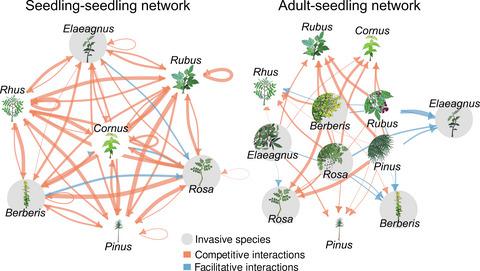Our official English website, www.x-mol.net, welcomes your
feedback! (Note: you will need to create a separate account there.)
Uncovering structural features that underlie coexistence in an invaded woody plant community with interaction networks at multiple life stages
Journal of Ecology ( IF 5.3 ) Pub Date : 2020-08-13 , DOI: 10.1111/1365-2745.13489 Nicole L. Kinlock 1
中文翻译:

发现在入侵的木本植物群落中共存的结构特征,以及在多个生命阶段的交互网络
更新日期:2020-08-13
Journal of Ecology ( IF 5.3 ) Pub Date : 2020-08-13 , DOI: 10.1111/1365-2745.13489 Nicole L. Kinlock 1
Affiliation

|
- Understanding the patterns of competitive and facilitative interactions within and among species in plant communities is a central goal of plant ecology, because these patterns determine species coexistence and community dynamics. Network theory provides tools that allow these patterns to be quantified, and can provide greater understanding of important community properties, including community stability, than can documenting pairwise species interactions.
- I characterized the interactions of multiple, co‐occurring invasive and native species in an old field woody plant community to build plant interaction networks at two different life stages. With the goal of identifying structural features that may operate to maintain species coexistence, I characterized the architecture of these networks at multiple scales: the entire network, the substructures that compose the network and species' roles within substructures.
- I found that species‐level pairwise interactions alone did not provide an accurate or sufficiently detailed picture of community structure. Rather, using a network approach, I identified substructures that have the potential to promote and hinder species coexistence in interactions among seedlings. Characterizing the nuances of network substructures was illuminating, as the size of the substructures and the pattern of interaction intensities within substructures influence the expected effects on species coexistence. Including interactions at multiple life stages was also important; the seedling species that benefited most from the nested structure of facilitative interactions with adults occupied subordinate roles in substructures with other seedlings. This role reversal at different life stages is a potential factor promoting coexistence in the community. Last, the network framework was useful for comparing species' roles between native and invasive members of the community, and the three invasive species in this system had different, life stage‐dependent strategies in interactions with co‐occurring plants.
- Synthesis. The interplay of network architecture and substructures within plant communities and among plants at different life stages is important for understanding species coexistence. In the plant community characterized in this study, there were several features that may promote coexistence, and these features were not observable in interactions within a single life stage or when considering pairwise interactions independently.
中文翻译:

发现在入侵的木本植物群落中共存的结构特征,以及在多个生命阶段的交互网络
- 理解植物群落中物种内部和物种之间竞争性和促进性相互作用的模式是植物生态学的主要目标,因为这些模式决定了物种共存和群落动态。与记录成对物种相互作用相比,网络理论提供的工具可以量化这些模式,并且可以更好地理解重要的群落特性,包括群落稳定性。
- 我描述了一个古老的田地木本植物群落中多种同时发生的入侵和本地物种之间的相互作用,以建立处于两个不同生命阶段的植物相互作用网络。为了确定可用于维持物种共存的结构特征,我在多个尺度上对这些网络的体系结构进行了描述:整个网络,组成网络的子结构以及物种在子结构中的作用。
- 我发现仅物种级别的成对相互作用并不能提供准确或足够详细的群落结构图。相反,我使用网络方法确定了可能在幼苗之间的相互作用中促进和阻碍物种共存的亚结构。表征网络子结构的细微差别是有启发性的,因为子结构的大小和子结构内相互作用强度的模式会影响对物种共存的预期影响。包括多个生命阶段的互动也很重要;从与成虫的便利相互作用的嵌套结构中受益最大的幼苗种类在与其他幼苗的子结构中占据次要角色。这种角色在不同生活阶段的逆转是促进社区共存的潜在因素。最后,网络框架对于比较社区的本地成员和入侵成员之间物种的作用非常有用,并且该系统中的三个入侵物种在与共生植物的相互作用中具有不同的,取决于生命阶段的策略。
- 综合。植物群落内部以及处于不同生命阶段的植物之间的网络架构和子结构之间的相互作用对于理解物种共存至关重要。在这项研究中表征的植物群落中,有一些特征可以促进共存,并且在单个生命阶段的相互作用中或独立考虑成对相互作用时,这些特征是不可观察的。











































 京公网安备 11010802027423号
京公网安备 11010802027423号